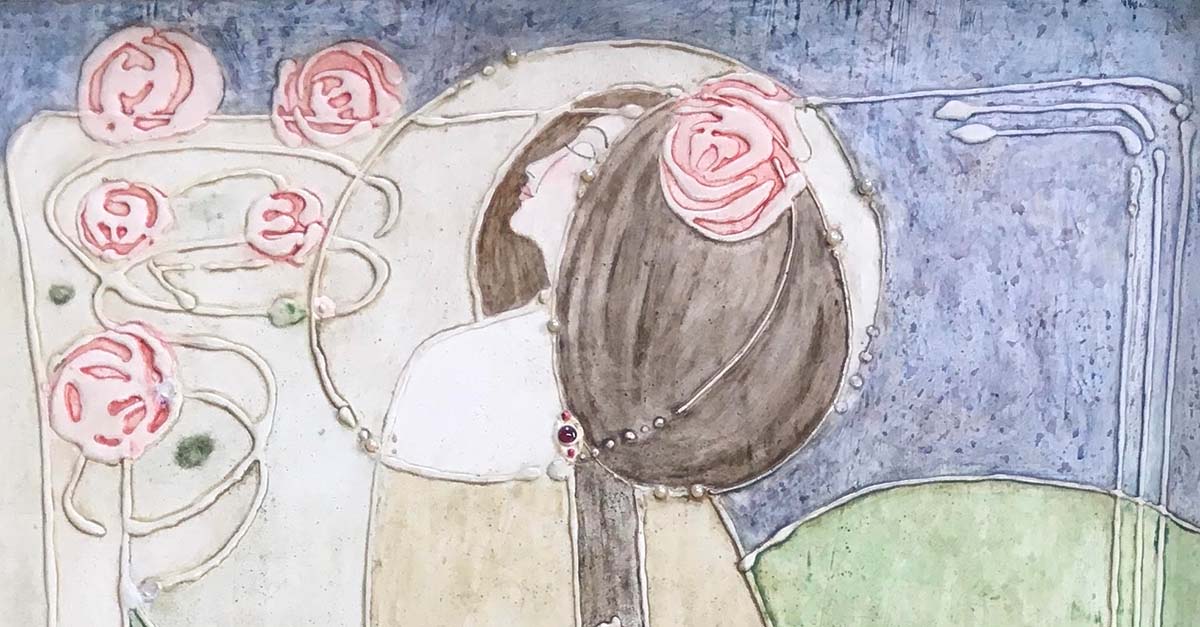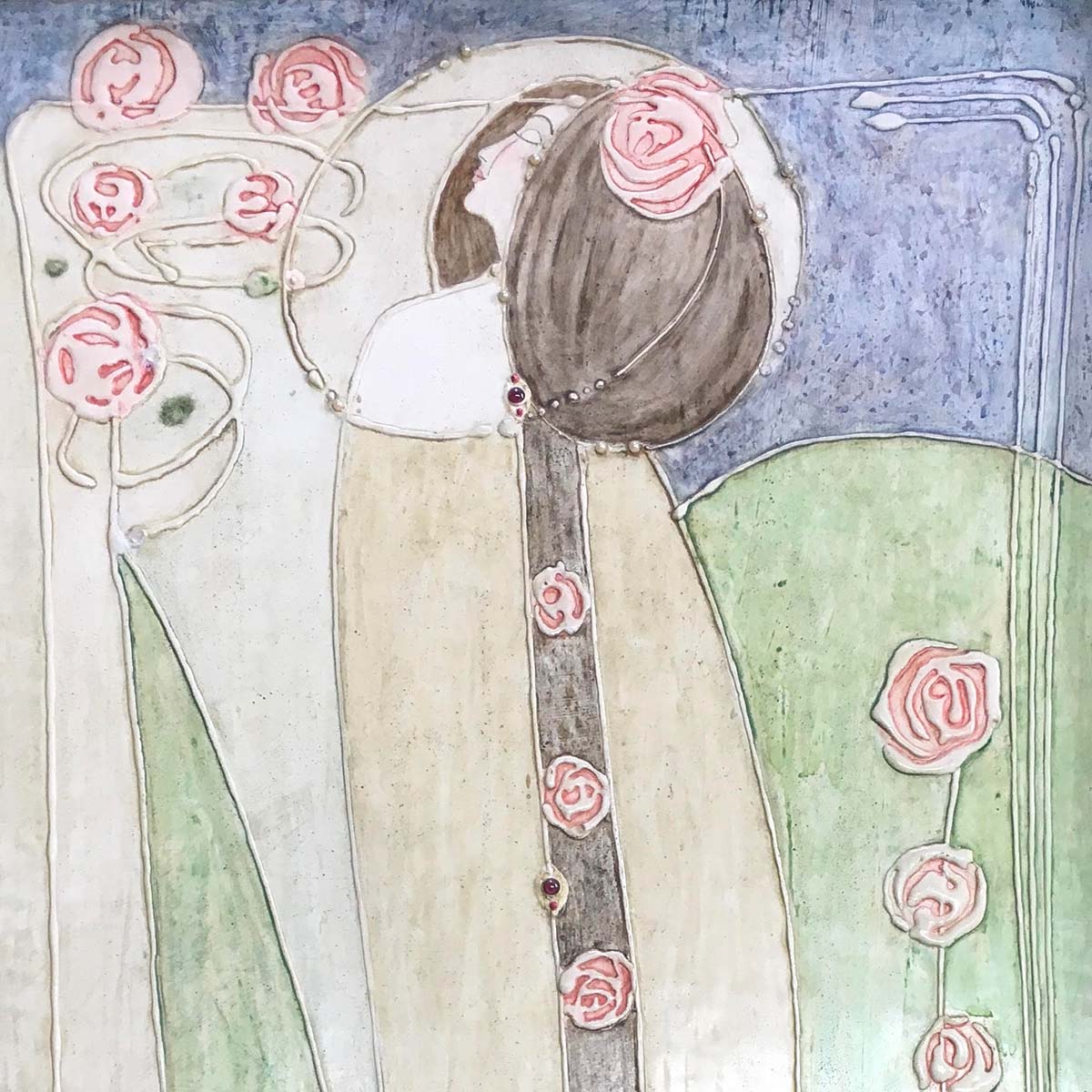He cast an eye over the panels and then looked at them very closely. Finally, he said we were certainly on the right track, which was praise indeed. However, as he left, and I was just closing the door, he turned and said “You must sign them”. I replied that we didn’t know whether we should or not and he said “Definitely Yes, because in years from now people will come, who wouldn’t know about our involvement, and so would think that these were genuine Margaret Macdonald gesso panels. “
In this way he insisted that we sign the panels ourselves, which is what we did from then on. First, we painted our signatures, but later we signed in gesso as Macdonald herself had done.
Eventually we presented the panels to Graham, and I’m happy to say that he was very pleased, and we received our final stage payment. These four panels can be seen illustrating Part 1 of my article.
We imagined he’d show these panels to people and in this way raise further funding for us to continue, but nothing happened. Eventually, wondering what was going on we got in touch and were told that from now on we’d have to raise our own funding as he was too busy. This news rather floored us but we started thinking about all the people that we knew who had an interest in the work of the Mackintoshes, and who might possibly be able to afford to commission a panel or two.
We’d rather given up in despair when I remembered about my youngest brother’s mother in law, Patricia Thomson. We’d only met once, at Johnny and Sandy’s wedding, but we remembered that she’d been to Glasgow University and said she was a great Mackintosh fan. Also, rather importantly, she was married to Brian Thomson, whose family firm was DC Thomson, and so she did have the funds, if she was interested.

Fortunately, she loved the idea and came up with the suggestion that she would pay for two panels for the Dining Room at The Art Lovers House, on condition that we secretly did two exact copies for herself, to hang on oak panelling in the family home near Dundee.
There followed a bit of paperwork, as it was to be the firm itself which paid the money, and very soon we were busy working on the panels.
Fortunately, in the time that had passed we had started to further perfect our gesso technique and had looked at Macdonalds work in greater detail. The gesso panels that we were able to arrange to see were The Heart of the Rose at Glasgow School of Art, The Sleeping Princess at The Hill House, The White Rose and the Red Rose in the Mackintosh House at the Hunterian Art Gallery, O ye, all ye that Walk in Willow Wood in Kelvingrove Art Gallery and Museum, and Summer at the National Museum of Scotland in Edinburgh.
We set to work preparing the two panels and decided to follow what we could see of two of the panels on the left-hand wall in Mackintosh’s perspective drawing. All we could make out were the very few lines of the design, and so these two panels were a lot less complex and much simpler in every way. These felt much better, were less forced and were much more successful.
On completion we arranged for the two for Pat Thomson to be framed by cabinetmaker Piers Kettlewell, who had completed all the woodwork and most of the furniture in the Art Lovers House.
Happily, Patricia Thomson was extremely pleased with her panels, and so was Graham with the two for the house. However, after this we drew a blank as we didn’t know anyone else with the combination of having money and a love of Mackintosh.
Also, it was gradually becoming clear to Graham, that this project was a lot more expensive than he imagined it would be, as he was building to such a high standard and so finally, he had to admit defeat and declare the Art Lovers House company insolvent. The house was boarded up and there it stood in Bellahouston Park looking very sad and abandoned.
People said it was just a white elephant, should never have been attempted and was simply an embarrassing disaster.
For years it stood there until it was decided that there should be a major celebration of Mackintosh’s architecture and the council, amongst others, started to receive letters from all over the world with people expressing great interest in seeing the Art Lovers House. After all the design was a major leap forward for the Mackintoshes, and through the publication of the portfolio of their design drawings for the house, which received such praise in Vienna, they became internationally famous as leading lights in the Modernist Movement.
Glasgow City Council became increasingly embarrassed and the decision was made in 1995 to purchase the house and place it in the hands of Glasgow School of Art to complete. This followed a visit in 1992 to the site by the director of the school, Dougal Cameron, who expressed the opinion that it wasn’t so much a house as an art school, and what a marvellous addition to the Glasgow School of Art it would be if it housed post graduate students. Consequently, this is what happened on the upper floors, where the bedrooms would have been.
We were naturally delighted, as we could see that we could at last complete the task we had begun. However, time passed, and we didn’t receive any word about re-starting. So, I went to see Bruce Baird of GD Lodge & Partners, who was the overall architect of the project, at his office, and enquired about what was going on. He was encouraging and said that decisions were taking a long time on everything but that he’d be in touch as soon as he heard anything. More time passed.
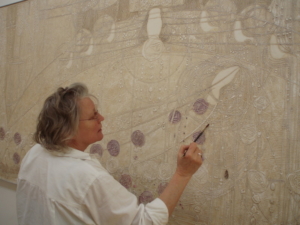
I spoke to him again and he confirmed that he felt we were the only people with the expertise to complete the work, so to just have patience.
Meanwhile, eighteen months went past and unknown to anybody, we were in real financial difficulty to the point of almost losing our home.
Finally, as Bruce had promised, we did indeed receive a phone call. He was speaking from a meeting in Park Circus, attended by all those making the final decisions on the house and contents.
He told us that it had been agreed that we should do the gesso panels, but we had to follow the designs made by a head of department at the art school.
Jenny and I had no hesitation in turning this offer down, despite our terrible financial position. We simply said that either we do the whole thing or not at all. We were not going to work to anyone else’s designs.
Frankly, by this point we had realised we knew more about how Macdonald worked than anyone else and so working under someone else’s directions would be ridiculous.
Apparently, our answer stunned the committee but finally, next day, it was decided that we should do both the design and the actual gesso work and the price we had quoted had been accepted. We should therefore come straight up to the office and sign the contract.
I lost no time in doing this and on my way back I called into the bank and showed them my copy of the contract. Our eighteen months of anxious waiting was now over, and we could set to work.
The first thing that happened was that Andrew Macmillan, the Director of the Mackintosh School of Architecture and Jimmy Cosgrove, Depute Director of the art school came to our studio to discuss how we would proceed with the work.
What they said was that they very much liked the two panels which had been commissioned by Pat Thomson, and much preferred them to the first four panels. We totally agreed with this in every respect.
They then told us they had decided that we should work directly from known gesso panels by Macdonald and basically copy sections from them. In this way they said the panels would be as authentic as possible.
We thought this was a crazy way to proceed, especially as we needed to make twenty four panels and Macdonald had only completed fifteen in total. However, at this stage, we could only agree to do as they advised.
We made good progress. Everything we did met their approval as they made further visits to our studio, but we were feeling increasingly uneasy about what we were doing, although our gesso technique was improving.
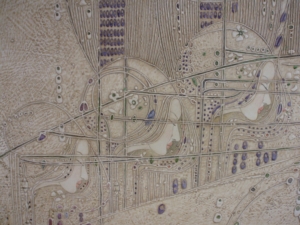
Nine panels had been completed and passed and paid for when we saw in the paper that a huge gesso panel by Macdonald had been discovered in the basement of the Museum of Arts & Crafts in Vienna. We unquestionably had to see it but there were no flights at that time from Scotland to Vienna and what flights there were from further south were very expensive. Despite this we contacted the museum and started an intense fax correspondence with Manfred Trummer, who had been in charge of the restoration of the panel.
Just at that point, we saw an advert in the Glasgow Herald for a day trip to Vienna, including a sight-seeing tour of the city. Needless to say we immediately booked ourselves on this trip. We would now be able to meet Manfred, discuss all the technical aspects of the work and actually see the restored panel for ourselves, which was entitled The Seven Princesses, from the play of that name by Maurice Maeterlink, published in 1891.
We also read all we could about this panel, which was designed and made specifically for Fritz Warndorfer (1868-1939), who was founder and one of the main patrons of the Wiener Werkstatte, which was led by Hoffmann and Moser, and was born from the Secessionist Movement. The panel had been specifically commissioned as one of a pair for Waerndorfer’s Music Room which had been designed by Mackintosh in 1902. The other panel, The Arrival of Prince Marcellus, which was to be designed and made by Mackintosh, has never been found and there is the possibility that it was never made although designs for the panel are in the collection of the Hunterian Art Gallery.
It seemed what happened was that at the outset of WW2 an astute curator at the museum realised that this panel was in great danger of being vandalised and possibly destroyed, as it would be deemed to be the work of the enemy. He therefore, had crates made for the three sections of the work, and one night he supervised the taking down of the panel, which was on display at the time, and replaced it with other work.
The panels were put into the crates, sealed and taken down to the basement and placed against a wall. He then organised that a wall was built in front of the crates and painted to blend in with the other walls.
(The reason that the panel wasn’t in Waerndorfer’s house was because after 1908 his finances suffered due to his paying off all the debts of the Wiener Werkstatte, which led to his eventual bankruptcy. The contents of the house were, it’s believed, taken by the state in lieu of tax, and placed in the care of the museum.)
There they remained hidden and forgotten until revealed by workmen doing renovations in 1990, and what was of particular interest to us was that the panels were preserved with their original colours. This was incredibly important, as all Macdonalds panels that we’d seen so far had suffered years of tobacco smoke, and air pollution, which had dulled their colours, and given the surfaces a sepia tint.
The great day arrived and as soon as we boarded the coach at the airport, we asked the driver to kindly drop us off at the Museum, as we didn’t want to go on the tour. He agreed and when we got to the museum, Manfred soon appeared and took us straight up to see the panel, but before we could really look at it he insisted that we read the text. This pointed out that Macdonald had been a great influence on Gustav Klimt. We were taken aback by this as we had always assumed the influence had been the other way around.
In fact, Macdonald’s huge work (measuring almost 20 ft wide) was surrounded by paintings by Klimt but shone-out in its large glass display case.
He then showed us around the Arts and Crafts Room, and we once more saw the cabinet by Mackintosh, with the two interior gesso panels by Macdonald.
After this, he took us to his studio and showed us photographs of all the various stages of the restoration he’d completed. We could see the number of layers of gesso and how the ground had been prepared. In all it was a very enlightening experience, and the lovely part was that he was clearly as enamoured of the panel as we were.
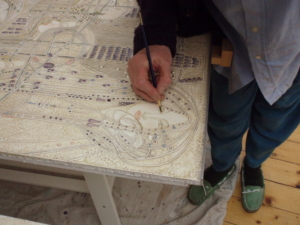
He then took us for lunch in the Museum restaurant and told us more about the restoration and also the various sights we should see. Unfortunately, we had no time to follow his advice as we needed to re-join the tour group before the coach headed back to the airport. We did decide though that we would return, which indeed we did several years later, when we went back and stayed for several days to study the panel further, due to receiving a commission to make an almost full-size version.
We returned to Glasgow and realised that all the colours that we’d used on the panels done so far were far too dark and muted. This combined with Jenny’s thoughts about the direction the panels were taking made us stop in our tracks and re-consider the whole project.
What Jenny had been thinking was that copying work like we had been doing was not what Macdonald would have done. She always worked to a theme such as a mythic tale of Celtic legends or illustrating a poem which had a deeper meaning of some kind. The Mackintoshes never did decoration.
Our thoughts on all this were confirmed by the appearance in the studio of James Macaulay, a Senior Lecturer at the Mackintosh School of Architecture, who had written several books on Mackintosh.
He listened to our reasons for starting again and agreed that a theme or story connecting the 24 panels was the right way forward.
However, we had a major problem on our hands. We were going to have to convince Macmillan and Cosgrove, of the reasons for restarting the series. Following our phone call requesting a meeting it was only Andy Macmillan who arrived.
Naturally, he was taken back by what we said, but he listened attentively and then took a few minutes to consider it all. Finally, he said we were absolutely correct, and he would back us all the way. It was a transformational moment.
We next day received a visit from the head of GA Group who were doing the construction work and were the main contractors on the job. He was not happy. He reminded us that we’d signed a contract to complete all the work by a certain date and that time was closing in and it wasn’t long before everything had to be finished and the house opened to the public.
He also reminded us that we’d been paid for what we’d done but calmed down when told that we’d do all the extra work at our own expense. There would be no charge for making the further nine panels. People redoing work at their own expense was clearly unheard of in his world. Finally, he agreed that we should go ahead.
Now, we had to think about the theme really seriously. We considered all the books of legend, poetry and philosophy that we reckoned she must have read to have produced the work she’d done in every medium from repoussé work through water colours, to the gesso panels.
We came to the definite conclusion that as the rose was their prime symbol, what we did would have to reflect their belief in the spiritual nature of the rose, of how esoterically the rose in the West is considered in the same way as the lotus in the East, and of how the poem The Rose, by WB Yeats and published in 1893, has nothing to do with gardening but with something much more profound. We thought of her love of the tales of Ossian, of which she had several copies. We thought of their belief in the words of Maeterlinck and finally, having considered all this and more, Jenny decided the theme should be The Life of the Rose, which could be read on many levels but as far as most people were concerned, it was a love story.
This theme works perfectly as the rose is neither male nor female but both.
So, personifying this, on the left-hand wall is the female side, the anther, and on the right-hand wall is the male side, the stamen. On the end wall you have the combining of both male and female figures, seen together in those four panels. This creates what can be called a mystic marriage, which may seem unreal to us today but at the turn of the century, when the Mackintoshes designed this house, would have been completely understood.
The Mackintoshes married in 1900, which is when they heard about the competition and started work on their designs, and now the House for an Art Lover is highly prized as a place to be married.

